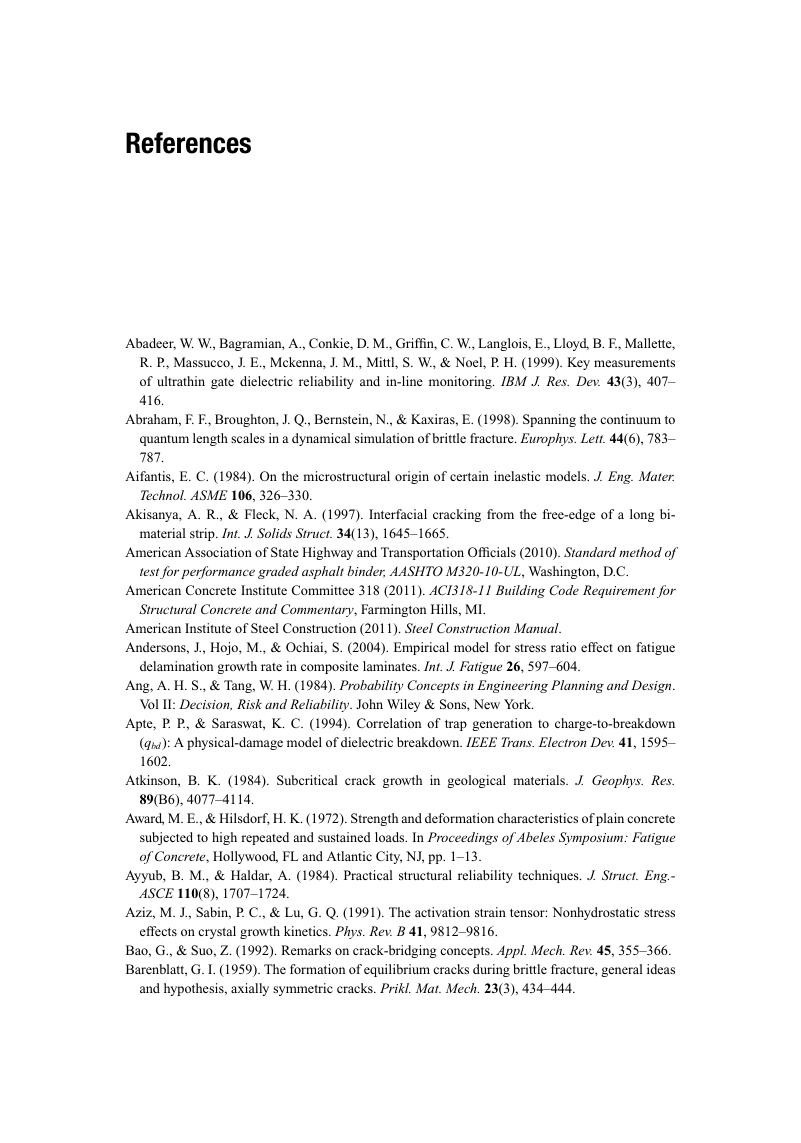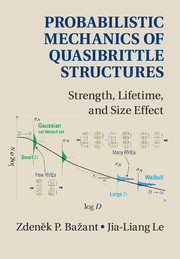Book contents
- Frontmatter
- Dedication
- Contents
- Foreword
- Preface
- 1 Introduction
- 2 Review of Classical Statistical Theory of Structural Strength and Structural Safety, and of Statistics Fundamentals
- 3 Review of Fracture Mechanics and Deterministic Size Effect in Quasibrittle Structures
- 4 Failure Statistics of Nanoscale Structures
- 5 Nano–Macroscale Bridging of Probability Distributions of Static and Fatigue Strengths
- 6 Multiscale Modeling of Fracture Kinetics and Size Effect under Static and Cyclic Fatigue
- 7 Size Effect on Probability Distributions of Strength and Lifetime of Quasibrittle Structures
- 8 Computation of Probability Distributions of Structural Strength and Lifetime
- 9 Indirect Determination of Strength Statistics of Quasibrittle Structures
- 10 Statistical Distribution and Size Effect on Residual Strength after Sustained Load
- 11 Size Effect on Reliability Indices and Safety Factors
- 12 Crack Length Effect on Scaling of Structural Strength and Type 1 to 2 Transition
- 13 Effect of Stress Singularities on Scaling of Structural Strength
- 14 Lifetime of High-k Gate Dielectrics and Analogy with Failure Statistics of Quasibrittle Structures
- Appendix A Power-Law Scaling of Boundary Value Problems
- Appendix B Proof of Transitional Size Effects of Types 1 and 2 by Dimensional Analysis and Asymptotic Matching up to Second Order
- Appendix C Proof of Small-Size Asymptotics of Cohesive Crack Model up to Second Order
- References
- Author Index
- Subject Index
- References
References
Published online by Cambridge University Press: 14 June 2017
- Frontmatter
- Dedication
- Contents
- Foreword
- Preface
- 1 Introduction
- 2 Review of Classical Statistical Theory of Structural Strength and Structural Safety, and of Statistics Fundamentals
- 3 Review of Fracture Mechanics and Deterministic Size Effect in Quasibrittle Structures
- 4 Failure Statistics of Nanoscale Structures
- 5 Nano–Macroscale Bridging of Probability Distributions of Static and Fatigue Strengths
- 6 Multiscale Modeling of Fracture Kinetics and Size Effect under Static and Cyclic Fatigue
- 7 Size Effect on Probability Distributions of Strength and Lifetime of Quasibrittle Structures
- 8 Computation of Probability Distributions of Structural Strength and Lifetime
- 9 Indirect Determination of Strength Statistics of Quasibrittle Structures
- 10 Statistical Distribution and Size Effect on Residual Strength after Sustained Load
- 11 Size Effect on Reliability Indices and Safety Factors
- 12 Crack Length Effect on Scaling of Structural Strength and Type 1 to 2 Transition
- 13 Effect of Stress Singularities on Scaling of Structural Strength
- 14 Lifetime of High-k Gate Dielectrics and Analogy with Failure Statistics of Quasibrittle Structures
- Appendix A Power-Law Scaling of Boundary Value Problems
- Appendix B Proof of Transitional Size Effects of Types 1 and 2 by Dimensional Analysis and Asymptotic Matching up to Second Order
- Appendix C Proof of Small-Size Asymptotics of Cohesive Crack Model up to Second Order
- References
- Author Index
- Subject Index
- References
Summary

- Type
- Chapter
- Information
- Probabilistic Mechanics of Quasibrittle StructuresStrength, Lifetime, and Size Effect, pp. 269 - 290Publisher: Cambridge University PressPrint publication year: 2017



